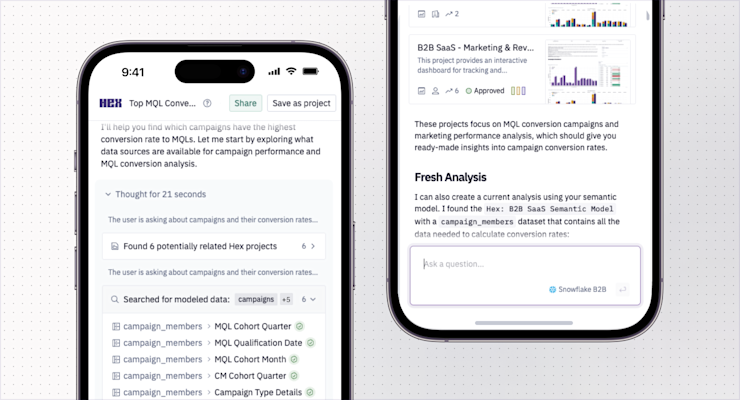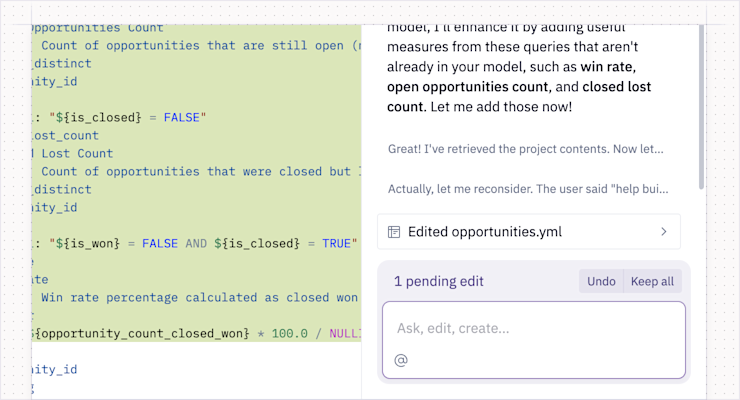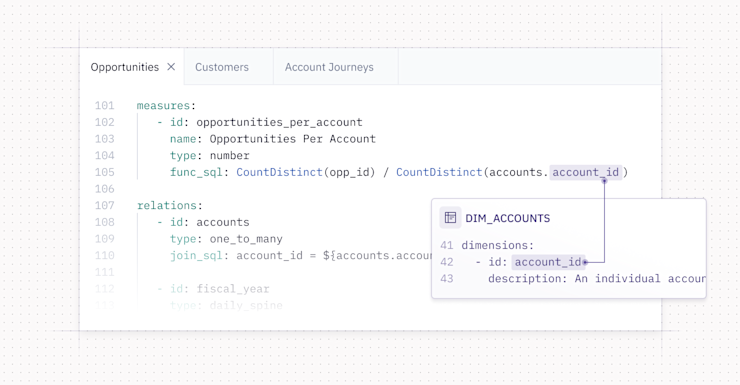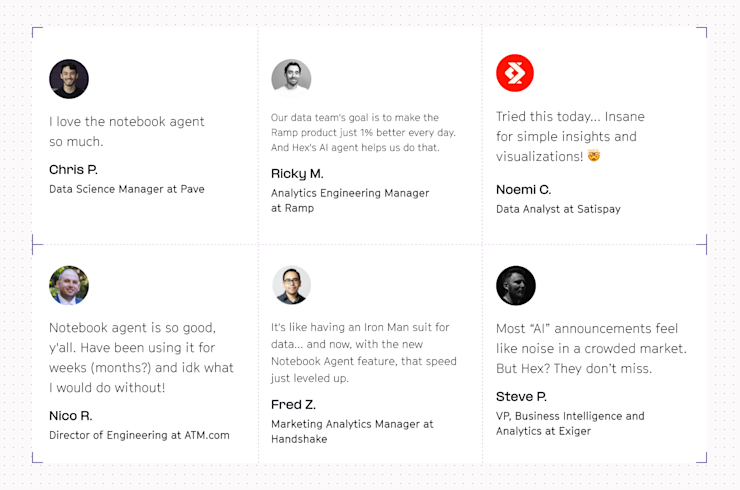AI is proving to be useful for all sorts of things, but accurate data analysis hasn’t really been one of them… yet.
There’s a lot of noise, and standalone point solutions — but when we talk to folks, we hear a lot more headaches than success stories.
But at Hex we’re obsessed with this, and have been working very hard on some new ideas for how to make data analysis work amazing in the AI era.
We’re building a connected solution for analytics and agents — with tools for complex data analysis, self-serve, and data apps all in one place — grounded in curated context to make it all accurate.
In many ways, this is just a continuation of the mission we’ve been on: building a unified solution that makes everyone a data person. But it also feels like a whole new chapter, focused on how we can apply these magical thinking robots to the ubiquitous challenge of data analysis.
So, today is probably Hex’s biggest release ever! It has by far the coolest stuff we’ve ever built, but more importantly sets the foundation for more to come. We can’t wait to hear what you think.
And on that note: everything below is live today. Some of these are in “beta” (read: may have the occasional rough edge, and will be evolving a lot) — but you can use them right now, no coming soon, no early preview, no “later this year.” Check them out now!
Introducing Threads: conversational analytics for everyone
Threads is an all-new interface for analytics, made for everyone who wants to answer questions with data. It’s built on the same powerful framework as our Notebook Agent — tailored with prompts, context, and tools meant for conversational insights.
See Threads in action at our live virtual event on October 7th at 11 AM PT / 2 PM ET!
Better yet, our team has been testing Anthropic's latest model, Sonnet 4.5, and we’ve seen significant improvements in speed, capability, and complex task handling for analytics tasks. We've already begun rolling out Sonnet 4.5 as our primary model, which will be available to all customers later this week.
Uses context and tools from your Hex workspace
It’s already becoming an over-tired adage: AI is only as good as the context it has.
Your Hex workspace already has data connections, projects, semantic models, workspace rules, endorsed tables, and schema docs – and Threads builds on what your team already knows by pulling context from these sources, so answers are relevant and trustworthy.
The integration with Hex has another benefit, too: Threads can leverage all the existing cells and capabilities as tools.
When creating viz, for instance, it uses Explore cells. These are fully interactive, powerful, beautiful interfaces for data exploration – and you can click into them at any time to edit and work with them more deeply.
Volleying to the data team via a notebook
When business users run into roadblocks or want to validate answers, the data team can turn a Thread into a notebook to easily extend or audit the analysis.
Notebooks make it easy to inspect charts, troubleshoot queries, or dive deeper with the help of the Notebook Agent. When insights are ready to share, your published work becomes context Threads can reference in future answers — creating a virtuous cycle where the more you build in Hex, the smarter Threads becomes.
The data team is in control
We believe data teams will play a critical role in defining and governing the quality of AI responses, much like they manage trusted dashboards today. It’s up to you to decide what data non-technical users can access in Threads, from semantic models to endorsed warehouse tables. In Hex, you have all the tools you need to define what’s trustworthy and how AI should use it.
A new homepage, with a big prompt bar
The homepage is now a launchpad into Threads — just type your question in the prompt bar, walk away to grab a coffee or switch tabs to respond to an email, and an answer will be waiting for you when you get back.
Looks great on mobile
Last thing: Threads is the first experience on Hex we’ve really dialed in for mobile. Our team has already started using it “on the go” and we’re excited to see if you do, too.

Threads is available to Explorers+ as a public beta on all Team and Enterprise plans. Extended AI usage limits are included for free during the early access period.
What we’re working on next
Again — everything above is live today, but we have a lot more in the works:
Observability for Threads usage and the answers users are getting
Initiating a thread from Slack!
Building data apps from threads
Don’t take our word for it
We’ve given Threads to some folks over the last several weeks, and they have some nice things to say!
Learn more about our differentiated approach with Threads from our Head of Product.
An agent for creating semantic models, too
About a month ago, we released the ability to build semantic models right inside of Hex with the help of a Modeling Agent that speeds up writing and validating changes to model definitions.
Since then, we’ve added the ability for the Modeling Agent to use your existing work in Hex and synthesize that code into semantic models. Just @ mention a Hex project, and the agent will inspect the code in the project and use it as context to join multiple semantic models together.
Improvements to the modeling workbench
Because the agent is able to make large-scale architectural decisions, we’ve added a diff view where you can review proposed changes and choose to accept or reject them. Paired with version history, it’s now easy to collaborate on semantic model development with your team and the agent.

New semantic model features
You can now define semantic models that work with snapshot tables using semi-additive measure definitions. This lets you specify which slice of data to use, like only using the latest month of data.
We also added the ability to define cross-model calculations, so you can pull a dimension from one model into a calc in another (same goes for measures), as long as there's a join path between them.

Committed to interoperability
Last week, we joined a great group of companies committed to the Open Semantic Interchange initiative, which supports a vision of semantic models that are more interoperable and portable.
We believe well-defined interchange formats will help data teams avoid lock-in and give them more flexibility and control. That’s why we released Semantic Sync earlier this year, and will continue to invest in deepening these integrations.
Explore keeps getting better
Roundabout a year ago, we first launched Explore — a rich, beautiful no-code data viz experience, built right into Hex. We’ve been hard at work since then — adding features, improving performance, and polishing edges, so more folks than ever before outside of the data team can dig into data.
Check out what’s new in Explore:
Top N: Want to identify the top 10 revenue-generating customers? You can specify the top (or bottom!) n values in a chart or pivot — and our agents have the ability to do this, too!
Aggregate calcs: For formulas like a ratio of sums or a weighted average, use Hex’s excel-like calculation language to tackle more complex aggregation logic without needing code.
Pivot totals and subtotals: We built the ability to add totals and subtotals directly to pivots, so you can skip the SQL and Python gymnastics.
And more here!
Improvements to the Notebook Agent
A few weeks ago, we launched the Notebook Agent and have been really blown away by the feedback.

Threads was built on the same framework, which means a lot of the things we’re showing above Just Work™ in the notebook too, including the ability to use semantic models. Now anyone can easily use curated context by the data team to do a deep-dive analysis or build a dashboard.
We’ve also made a ton of improvements to the Notebook Agent’s behavior and given it access to Hex docs to help you learn about all of Hex’s features. We have a ton more coming, so please keep the feedback flowing!
Everything is live, right now!
There’s lots of new stuff to try, and we’re excited to hear what you think. If you’re looking for some inspo on how data teams are rolling out Threads, join us for a live virtual event on October 7th to hear from PandaDoc on how they’re unlocking self-serve with Hex.